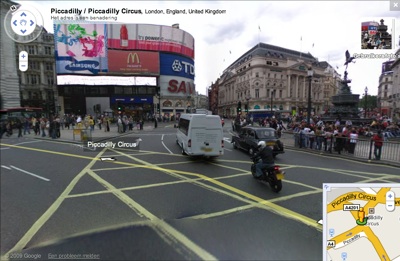Blog
Google Streetview & outdoor advertising

The new service Google Streetview is also interesting for outdoor advertising.
It is a very cool feature that lets you actually look around the street. It’s only working in major cities for right now, although the expansion is now going pretty fast. This will be a very handy tool for those relocating or looking at real estate online to get a feel for the neighborhood and traffic virtually.
For outdoor advertisers and agencies the opportunities are huge as well, for example:
- get a better feel for the specific location you are interested in
- control the clutter in the environment
- look what is happening in the surroundings
Banned designer billboard – it’s a pity

This new billboard ad for Armani|Exchange seemed to have all the necessary prerequisites to be highly successful. I mean, there is cleavage-dropping, sex on the beach, good looking Dutch model Rianne ten Haken and a hunky male model named Parker Gregory getting dressed and flaunting his perfectly round, naked butt in the process.
It all seemed so perfect.
However, to the dismay of Armani and the advertising agency that put this ad together, this gloriously raunchy advert will never see the light of day on a big city billboard. The drastic decision to nix the risque promo came from Van Wagner which is the billboard managing agency and the party which alleges that the image is too racy.
Unfortunately, and to our own dismay, we will never get to see this billboard promo in the notoriously decadent meatpacking district. That’s what I call irony.
source: www.trendhunter.com
First fully eco-powered billboard: windvertising
In the next few weeks, Japanese copy and photo manufacturer Ricoh will launch a Times Square spectacular powered by wind at 42nd and 7th Ave. The sign, using wind turbine technology developed by WePOWER, will be powered by 16 wind turbines and 64 solar panels, saving 18 tons of carbon per year and about $12,000 to $15,000 a month in electricity.
Ricoh isn’t the only advertiser to seek an eco-solution in outdoor’s most iconic locale. On New Year’s Eve, the Coca-Cola Co. launched its new digital billboard at 47th and Broadway powered by wind, offsetting the release of 1,866 metric tons of carbon dioxide a year.
WePOWER, which calls its eco-outdoor ad solution, “windvertising,” expects to work directly with advertisers on about 25 custom applications of its technology this year, expanding its footprint in 2010. The company is also in discussions with outdoor media companies about applying its technology in other locations.
In addition to the sign itself, windvertising could also be applied to the turbine’s air foil blades to reflect an image, creating a moving image.
“I always tell people to think of Windvertising as a flipbook that you played with as a child,” said Marvin Winkler, CEO of WePOWER.
According to Winkler, if the nation’s 500,000 billboards were to adopt Windvertising, the billboards, spinning at 10 mph would generate 16.8 billion kWh of electricity. They could power approximately 1.5 million homes and would reduce about 5.3 million tons of CO2 being emitted into the air.
Click hear to see a small video announcing the new technique.
Source: www.mediaweek.com
Stroer tests new digital outdoor advertising products
COLOGNE, Germany, Mar 02, 2009
With two European pilot projects, Stroer tests new digital outdoor advertising / Outdoor TV launched in Turkey / Installation of Infoscreen network in Warsaw underground stations
The Stroer Group, Germany’s leading and Europe’s third-ranking provider of outdoor advertising, is driving poster digitalization forward with two projects in major European cities. The new “Outdoor TV” project was recently launched in Turkey’s capital Ankara, now connecting screen on busy thoroughfares and in underground stations for the first time. 30 screens are currently available in Ankara.
In Warsaw, the capital of Poland, 23 Stroer Infoscreens are available in six underground stations. In a few months, Stroer will expand the network with 11 additional screens in five more stations.
Udo Muller, Board Chairman of Stroer Out-of-Home Media AG explains: “Our pilot projects are a big step towards the digitalization of our media. The most important benefits for our customers include short lead times, more options for campaigns with multiple motifs and individual advertising updates depending on the time of day or the region.”
For the development of the new projects abroad, Stroer utilized the competence of its subsidiary, Stroer Infoscreen. With more than 240 digital screens in underground and elevated train stations, mainline railway stations and airports, Stroer Infoscreen is present in 19 cities across Germany, which makes the company the German market leader in electronic poster advertising.
While the project in Poland relies on Infoscreen technology with a mix of news, weather forecasts, sports, culture and advertising, Outdoor TV Turkey has a completely new approach. The network of screens on the streets and in underground stations offers new possibilities of synchronizing content above and below. Thanks to the latest technology, the outdoor TV screens are brighter, sharper and have a higher outdoor visibility than regular digital advertising media.
New platform for planning, buying and selling digital out-of-home media
Source: www.mediapost.com / Country: US
In a bid to become the industry standard platform for planning, buying and selling digital out-of-home media, SeeSaw Networks is announcing deals that will license its technology to buyers and sellers who want to utilize it to manage their own inventory. On the sell side, CBS’ Outernet division has become the first outside sales organization to adopt the new “Powered by SeeSaw” system. On the buy side, fledgling digital media shop Digital Hive has become the first agency to standardize its digital out-of-home media planning and buying system around a new Web-based platform, SeeSawAds.com, that will enable advertisers and agencies manage their digital out-of-home campaigns.
The initiatives bring SeeSaw one step closer to realizing its dream of becoming the “Google” of the burgeoning digital out-of-home media marketplace, effectively becoming and standardized platform for aggregating the disparate, and rapidly expanding array of place-based video networks.
“We have to make this business easier for people to use, and we have to give people the opportunity to customize what they are doing,” says Virginia Cargill, president of CBS Outernet, which operates place-based video networks in grocery stores, automotive service centers, and the GameStop video game rental network. She says CBS Outernet effectively is making the Powered by SeeSaw its internal sales system, and that CBS made that decision after talking to a cross section of advertisers and agencies who liked the ease-of-use, and the sophisticated “life stage” approach to planning digital out-of-home media buys.
“A media planner can be sitting there at 1 a.m. and call it up on their laptop and plan a media buy to reach exact audience they are looking for. That’s a lot easier than calling us up and asking us to develop a plan,” Cargill explained, confirming that Powered by SeeSaw will now be CBS Outernet’s exclusive system.
Another advantage of the deal is that CBS retains control of its own inventory. SeeSaw does not handle sales for any of CBS’ place-based video networks.
The deal also gives advertisers who utilize SeeSaw more critical mass of the disparate digital out-of-home marketplace.
“We have close to 30,000 venues in the SeeSaw network and we’re still growing. CBS adds another 10,000 venues in their own right,” says SeeSaw chief Peter Bowen. Bowen says there are no good estimates for the overall size of the digital out-of-home marketplace, so it’s impossible to say what share SeeSaw represents with the new deal, but he notes the main advantage is that it adds deeper reach among key audience sectors that increase SeeSaw’s ability to fulfill the needs of national marketers in different categories.
CBS Outernet’s in-store reach, for example, brings deeper reach among so-called “alpha moms,” a life stage planning segment that marketers seeking to reach such consumers can now access more effectively.
Bowen says he expects other big digital out-of-home networks to license the Powered by SeeSaw system, because it also is becoming more of a default system among advertisers and agencies.
“They are the perfect planning model for this medium,” acknowledges David Matera, CEO of Digital Hive, an agency specializing in place-based video networks that was launched about a year ago. “If I’m looking to reach 18- to 34-year-old women, I can easily find every vendor that offers that audience.”